So you’re salty…
Most of us are. Sodium, the chemical element in salt, is literally everywhere — including our bodies. It’s an essential nutrient, which we must replenish like any other vitamin or mineral. We need sodium to survive, so there is no such thing as a sodium-free diet. That would kill you.
But perhaps you’re TOO salty.
The recommended daily sodium intake is between 1,500 – 2,300 mg (that’s between about 2/3 a teaspoon and 1 teaspoon, FYI), depending on your age and risk factors (we’ll help you find out how much you should aim for in a bit). But most Americans go way over that recommendation.
According to the National Health and Nutrition Examination Survey, the average sodium intake for all Americans is around 3,500 mg — that’s more than 1,000 mg of excess sodium every single day.
What happens when you have too much sodium?
Potentially, a lot of bad stuff. “Your body always tries to maintain a certain concentration of sodium in the body,” Emily Callahan, R.D., National Program Lead of the American Heart Association’s (AHA) Sodium Reduction Initiative, tells BuzzFeed Life. “Extra sodium in the bloodstream pulls more water into blood vessels and increases the total volume of blood inside, which raises your blood pressure.”
Consuming excess amounts of sodium can lead to hypertension (long-term high blood pressure), which is a major risk factor for heart disease, the number one killer worldwide.
Not to mention sodium can make you bloated AF.

Warner Bros. / Via damnstraightneednotapply.com
“When you eat too much salt, your body will retain more water and become bloated from the excess water weight you’re now carrying around,” Callahan explains. And we’re not just talking about post-meal belly bloat — excess sodium can cause puffiness in your fingers, toes, and face. Not cute.
You don’t get a free pass just because you’re young and healthy.
“It’s hard to motivate young people to cut back on sodium, because chronic high blood pressure is such a long-term outcome that takes years to build up,” says Callahan. “But even if you’re healthy and have low blood pressure, you don’t get a free pass.” Blood pressure inevitably rises with age, and according to the AHA, 90% of adults are expected to develop high blood pressure in their lifetimes.
“If you watch your sodium while you’re young, you can blunt that rise and decrease or even eliminate the risk of high blood pressure as you get older, which also helps to prevent cardiovascular disease and strokes,” she says.
SO we asked experts how to cut excess sodium out of your diet.
In addition to Callahan of the American Heart Associaition, BuzzFeed Life reached out to Rachel Beller, M.S., R.D., founder of the Beller Nutritional Institute in Los Angeles, California, and Tammy Lakatos Shames, R.D.N., and Lyssie Lakatos, R.D.N., The Nutrition Twins and authors of The Nutrition Twins’ Veggie Cure.
First, you need to actually KNOW how much sodium you’re consuming.
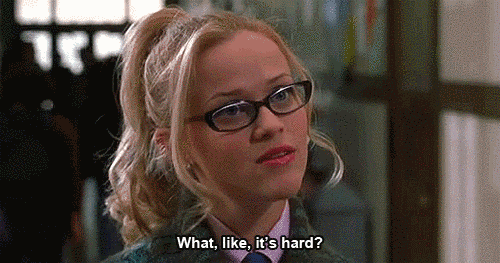
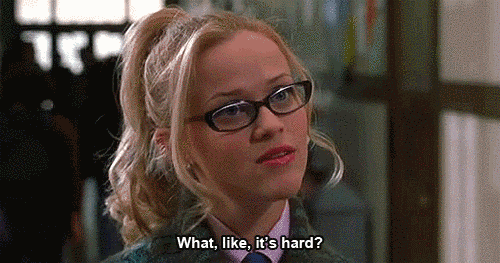
Metro-Goldwyn-Mayer / Via tumblr.com
According to a survey by the AHA, 97% of Americans either didn’t know or underestimated their sodium intake. Try estimating your own your daily intake by checking out nutrition labels, looking up food brands online, and visiting restaurant websites for nutrition information. You can also check out the U.S. Department of Agriculture National Nutrient Database for info on almost any food.
Once you get a good idea of how much sodium is in the foods you typically eat relative to the daily recommended amount, it will become so much easier and faster to cut the excess and make the right swaps.
Then find out how much sodium you should ACTUALLY be consuming.


Grace Helbig / Via whisperintoass.tumblr.com
The most recent Dietary Guidelines for Americans recommends all Americans reduce sodium intake to less than 2,300 mg per day. BUT they also say that about half the U.S. population should actually reduce their intake to 1,500 mg per day, since that’s the recommendation if you’re over 51, if you’re African American, or if you have hypertension, diabetes, chronic kidney disease, or a history of heart disease. The AHA does note that the 1,500 mg target doesn’t apply to people who regularly lose large amounts of sodium in sweat, such as athletes and workers exposed to heat. But basically, most people should be reducing their intake by at least 1000 mg.
Where exactly you fall in the 1,500-2,300 mg range really depends on your lifestyle and diet. It’s best to consult a doctor who can make a personalized recommendation based on your medical conditions and history. Even though 2,300 mg is the maximum recommended intake, it’s statistically a huge improvement from what you’re probably consuming and a great place to start. But if you have any risk factors, you may need to cut down even more.
Just a general example, if your goal is 2,300 mg per day, Callahan advises “allocating 500 mg for breakfast, 700 each for lunch and dinner, and 400 for snacks. If you’re planning on dining out for dinner, you can skimp on sodium on the other meals with the anticipation that the restaurant meal is generally going to be higher in sodium, around 700 mg.”
Set a 3-week goal to get less salty.
It only takes 21 days to “reprogram” your taste buds, says Callahan. All three experts agreed this was the best game plan because it has potential to translate into permanent lifestyle change. “People get used to a certain salt threshold, measured by your taste buds — similar to the number of Splenda packets in your coffee,” says Callahan. When you gradually cut down, super high-sodium foods you used to love will taste too salty eat.
A good place to start is the American Heart Association’s 21 day “Change your Salty Ways” plan.
Pay attention to nutrition labels, even if a food doesn’t taste salty.
“Almost 80% of sodium we eat is from processed, packaged, and restaurant foods,” Callahan explains. So cutting out some sodium may be as easy as actually reading nutrition labels. Make sure to look out for both “sodium” and “soda,” which can refer to baking soda or sodium bicarbonate.
IMPORTANT: When looking at the % Daily Value of sodium on a nutrition label, remember that it’s assuming you’re aiming for 2,300 mg per day. So if you’re trying to consume less than that, this will be a higher percentage of your daily sodium intake. So it might just be easier to jot down the mg of sodium you’re consuming instead.
And here’s what some of those common sodium labels actually mean: Sodium-Free: Less than 5 mg of sodium per serving and no sodium chloride. Very Low Sodium: 35 mg or less per serving. Low-Sodium: 140 mg or less per serving. Reduced (or Less) Sodium: At least 25% less sodium per serving than usual. Light Sodium: Reduced by at least 50% per serving.
Start small, and cut out the saltiest stuff first.
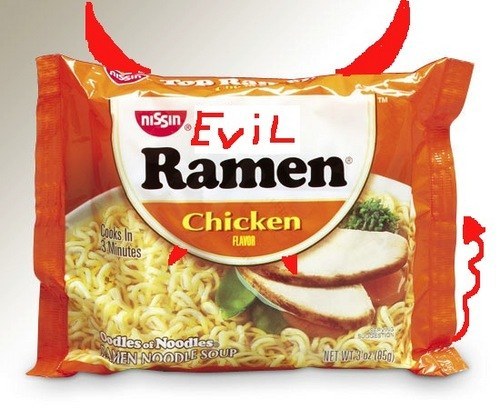
Beller suggests picking three items or snack foods you regularly eat with over 400 mg of sodium. Try to eliminate each item, or eat half as much, each week. For instance, ditching one or two packets of instant noodles per week can make a big difference, even if it seems like a small lifestyle change.
Keep a log to track your sodium throughout the day.


Universal Pictures / Via fundraisergrrl.tumblr.com
Jot down the milligrams of sodium in your usual breakfast, lunch, dinner, and snacks using the resources mentioned earlier and add these up throughout the day to make sure you’re falling in your recommended range. Getting in the habit of doing this will help you to be more mindful of the sodium content in food you regularly eat, and it’ll help you stick to your plan.
…Or let this free app keep track for you.
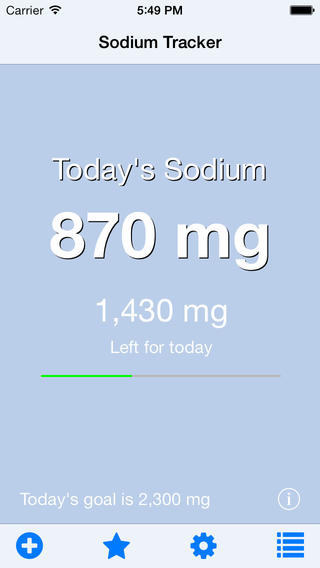
Apple / Via itunes.apple.com
Sodium Tracker is an easy way to track your sodium intake each day. And you can change your daily goal depending on whether you want to decrease or maintain your current intake.
Cook at home more often, and try to eat clean.
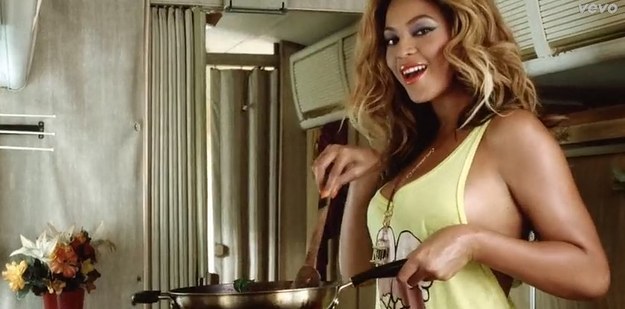
Beyonce Vevo / Via youtube.com
“The homemade version is always healthier,” says Callahan. “Processed food is packed with sodium to extend the shelf life and make it taste delicious, but it’s so bad for you. Cooking at home allows you to control the amount of sodium in your food and practice with flavorful herbs and spices as substitutes.”
And clean eating doesn’t have to be terrifying. “It’s really just eating foods that you can clearly identify — like a potato,” says Geller. “Generally, the rule of thumb is the less ingredients overall and the more ingredients you can understand, the better. You can either pick the fruit leather or an apple. The latter has one ingredient and is cheaper than the processed stuff.” If you have zero idea of where to start, here’s a that’s actually delicious.
Add salt after cooking, not during.
Table salt has about 575 mg for 1/4 teaspoon, but you’re generally using less when you sprinkle with a shaker. Here’s an easy suggestion from the Nutrition Twins: “When you salt your food at the very end, the salt touches your taste buds immediately and you taste it more instead of when it’s mixed in, like multigrain bread.”
When using salt, opt for bigger crystals and only sprinkle A LITTLE.
http://instagram.com/p/13FlYai8Oc
“Sea salt may sound healthier, but there is actually the same percentage of sodium by weight (about 40%) as regular table salt. The only advantage is they have larger crystal sizes, which have less sodium by volume,” says Callahan. So the theory is that if you use bigger crystals like flake or kosher salt, you’ll ~probably~ use less.
Always rinse canned vegetables and beans.
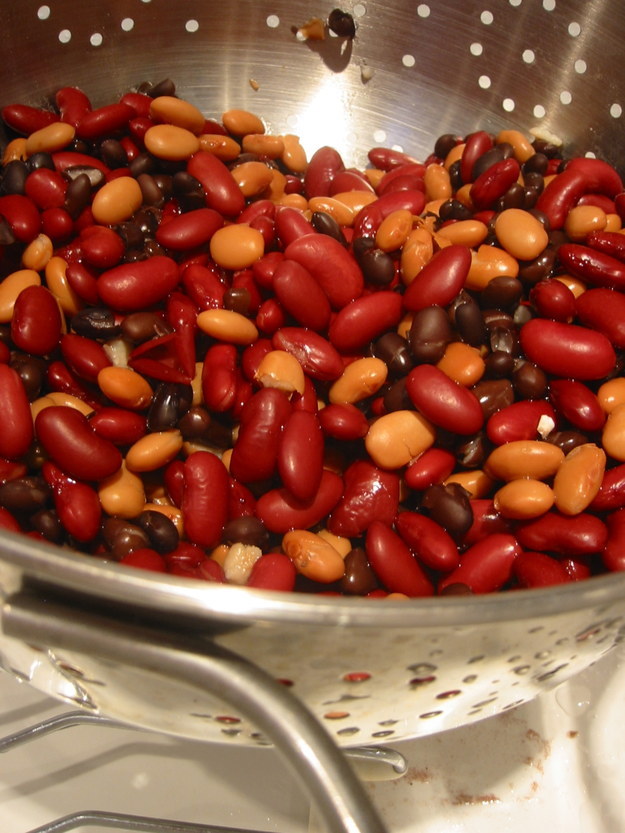
Jeremy Keith / Creative Commons / Via Flickr: adactio
“This simple trick washes out a huge amount of excess sodium,” says Geller. High sodium goods which could use a good wash include canned tomatoes, chickpeas, black beans, corn, and green beans. Also, who likes that cloudy saltwater stuff left in the can, anyways?
If you’re really serious, you can rinse your canned tuna too.

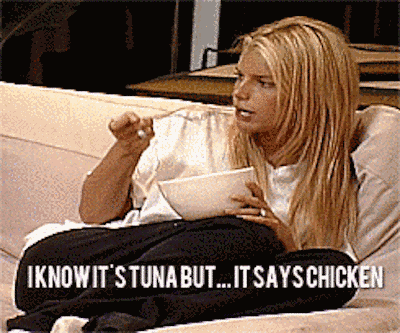
MTV / Via mtv.com
“A lot of my clients will rinse their tuna before they add different spices. You can really rinse anything!” says Geller. Pickles, olives, anything marinating in some salty juices.
Try avocado as a condiment.
Slopping on the ketchup, mayo, and mustard is an easy way to bump up your sodium, but there are so many low-sodium options that also taste amazing. Callahan suggests trying goat cheese, oil and vinegar, or horseradish.
And maybe just get rid of bread altogether, if you’re really feeling daring.
Two slices of regular packaged bread have about 300 mg of sodium alone. That’s a relatively large portion of sodium even though bread doesn’t taste very salty. The Nutrition Twins suggest looking for low-sodium bread options, or trying corn tortillas, lettuce-wraps, and rice cakes instead.
Ditch the rotisserie chicken — or at least eat it less often.


Comedy Central / Via shogunofyellow.tumblr.com
“Rotisserie chicken is delicious, but it’s also injected with sodium to keep it tasty and fresh in the supermarkets. You’re so much better off taking 12 minutes to grill some chicken breasts and adding your own spice rubs and citrus,” the Nutrition Twins say.
Don’t have a grill? Here’s .
Eat oatmeal instead of cereal.
“There’s a lot of sodium in your favorite cereals, even if they taste sweet. Try making your own oatmeal using quick-cooking oats or steel-cut oats — not the flavored packets!” suggest the Nutrition Twins.
Use crumbled seaweed snacks as a salty topping.
Skip the croutons and try these on your salad or soup. “These are actually really low in sodium for how salty they taste because they’re only salted on the outside and there’s a lot of surface area. Depending on the brand, an entire packet has 30-80 mg,” say the Nutrition Twins.
If a low-sodium substitute tastes disgusting, mix it together with the regular version.

bookchen / Creative Commons / Via Flickr: cpchen
Even the experts agree that low-sodium or sodium-free versions of your favorite sauces and soups can taste pretty bland. To keep the flavor, Callahan suggests buying one can of low-sodium and one can of your favorite normal version and mixing them together, which dilutes the sodium but not the taste.
Callahan recommends doing this with your favorite marinara sauce, then adding fresh herbs and spices before returning it to a jar and keeping your new lower-sodium sauce in the fridge.
Replace sodium-rich salad dressings with your own DIY version.
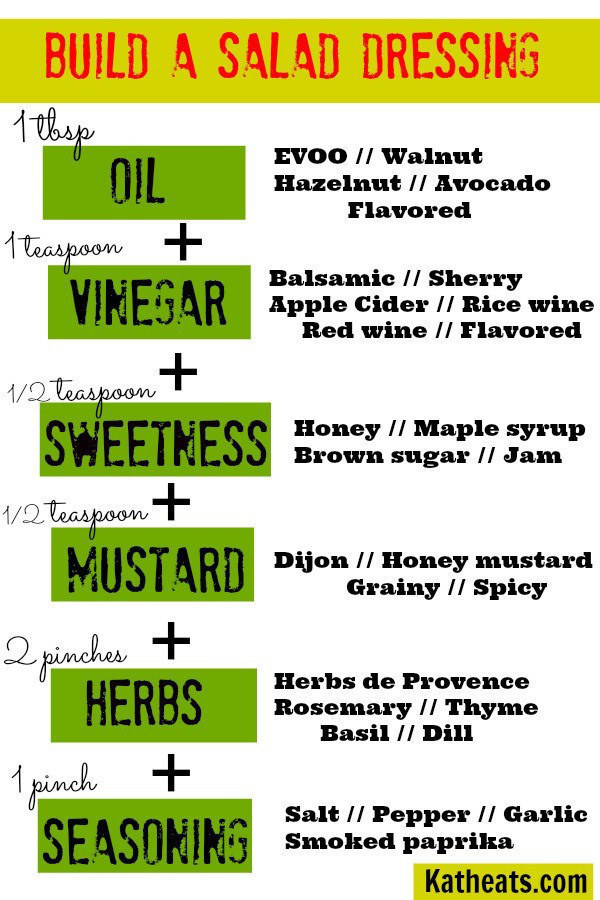
katheats.com / Via
Also, this is just fancy and impressive.
Swap bottled steak sauce and marinades for this tangy homemade recipe.
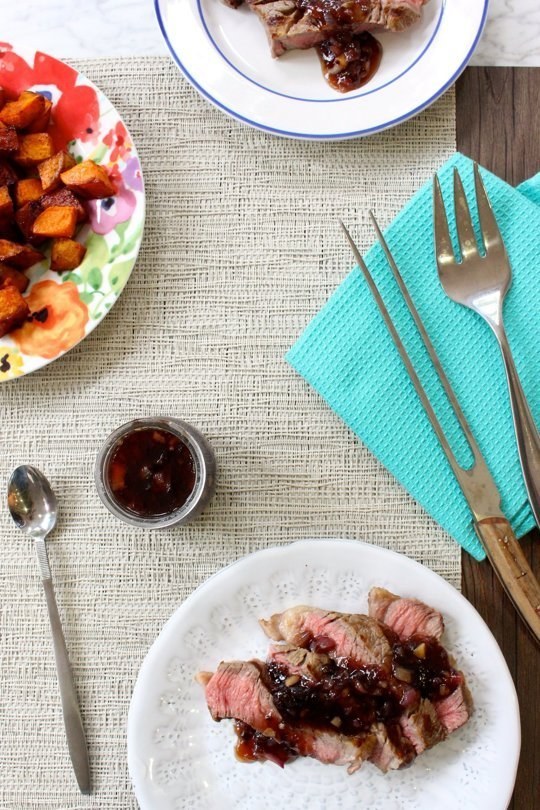
Jessica Goldman Foung / Via thekitchn.com
Packaged steak sauces are packed with sodium. Callahan suggests mixing a berry jam with balsamic or apple cider vinegar and then adding your own spices as an alternative. Here’s a delicious recipe from The Kitchn to get you started.
Additionally, you can prep your meat before cooking with a naturally low-sodium spice rub (try different combos of thyme, coriander, onion and garlic powder, or paprika) or a citrus-based (lemon, lime, orange) marinade.
If you’re at a restaurant where each dish is prepared to order, don’t be afraid to ask your waiter for less or no salt.
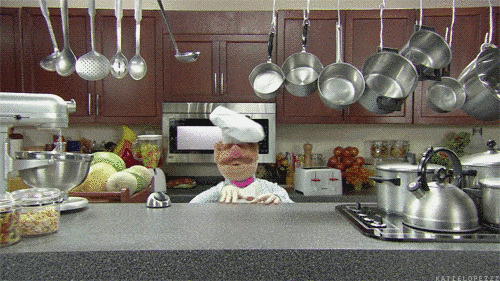
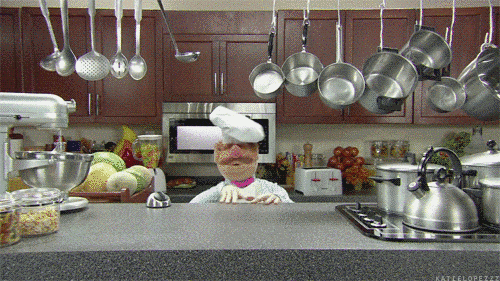
Associated Television / Via thisisawkwardnyc.tumblr.com
“Consumers should have a choice over what they eat. When the salt is already added in process, you have no control because you can’t take it out. If you order or buy unsalted food, you have control over the sodium,” Callahan explains. Most restaurants will be happy to ask the chef to prepare your food without adding salt, that way, you can add it at the very end if you really need it.
If you think it’s a weird request, just remember that there are a lot of people out there who have to stay on super low-sodium diets at or under 1,500 mg per day (like people with high blood pressure or heart disease), so you likely won’t be the first person who has asked this.
When you’re craving something salty, have a spoonful of natural peanut butter or a bowl of popcorn with spices (that aren’t salt).
Callahan calls these her “salty stand-ins,” which can help satisfy your cravings without sacrificing half your daily intake.
Look out for some of these sodium buzzwords.
Sodium red flags: Brined, cured, smoked, pickled, barbecued, teriyaki
Low-sodium safe words: Steamed, baked, poached, roasted
Obviously these don’t always tell you if something is high or low in sodium, but they’re a good rule of thumb to keep in mind, according to Callahan. Always check the nutrition information to be extra sure.
Ask for takeout veggies steamed plain — with sauce on the side.
This is where the Seamless special request box comes in handy. If you’re ordering something with meat and veggies (like Kung Pao chicken obviously), ask for everything to be steamed with the sauce on the side. That way you can dilute the sauce with water before adding a little bit back on.
Dilute your soy sauce.
http://instagram.com/p/3rRi-MRu9l
Dipping your sushi roll in soy sauce is an easy way to double your daily sodium intake without even realizing it. Regular Kikkoman soy sauce has 920 mg of sodium per one tablespoon, while the low-sodium version has 575 mg. And those little dishes they give you at sushi restaurants typically hold more than a tablespoon. “Even the low-sodium is really bad. Try diluting the soy sauce 50/50 with water, or lemon juice, and load up on the wasabi and ginger for extra flavor,” Geller says.
And if you must have olives and pickles, chop them up.
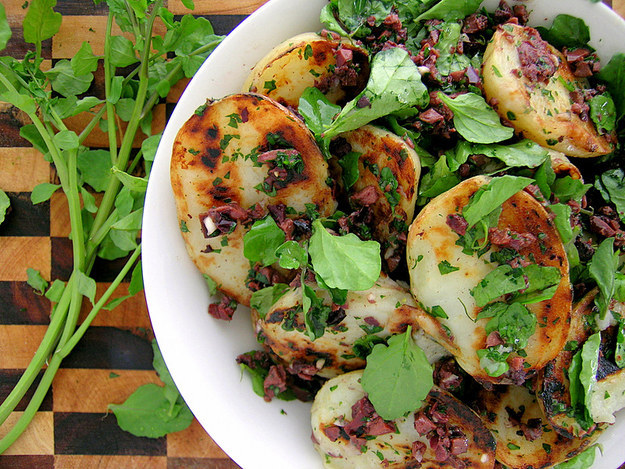
flickr user jamieanne / Via Flickr: jamieanne
No, this isn’t a fancy way to eliminate their sodium, but it’ll hopefully make you eat less of them. Here’s a helpful tip from the Nutrition Twins: Chop these into tiny pieces so you can sprinkle a few in you salads or sandwiches. This helps you disperse the flavor so you don’t feel like you’re missing out entirely.
Eat more potassium.
“Your body also keeps a certain sodium-potassium balance. When you eat a lot of fruits and veggies high in potassium, it can help to neutralize some of damaging effects of sodium,” Geller explains. So try to add some bananas, sweet potatoes, and spinach to your diet, too.
If you really stick to this, in three weeks you’ll probably be like:
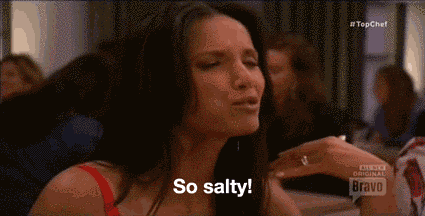
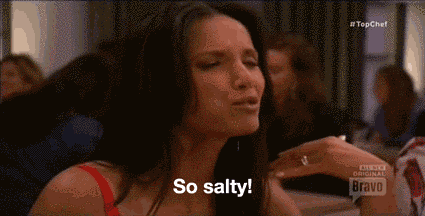
Bravo / Via topchefmoments.tumblr.com
Padma trained those taste buds.
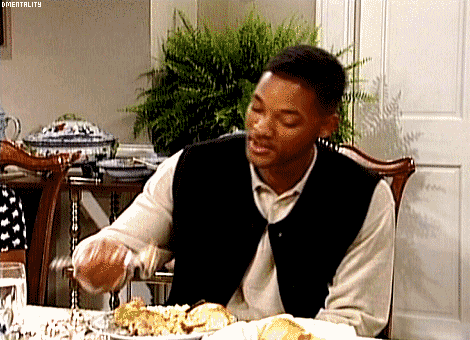

NBC / Via swide.com
Forkful of NOPE.
So don’t give up!
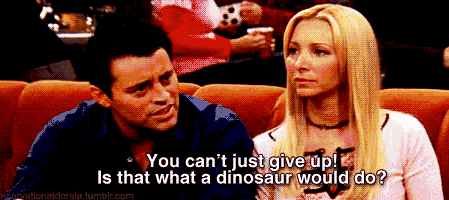

Warner Bros Television / Via bustle.com
“It will be a little uncomfortable at first. But once you get through it and make it to three weeks and you eat something salty, your taste buds will freak out, and then you’ll know that they have turned over,” explain the Nutrition Twins. Keep at it, it’ll get easier! Just remember all those sweet health benefits to being less salty.


















